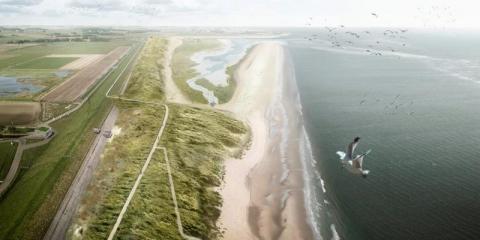Works on the Prince Hendrik Sand Dike kicked off

On Wednesday 25 July, Jan De Nul kicked off the works for the reinforcement of the Prince Hendrik Sand Dike over a distance of 3 km. After youth director and Texel resident Rodny Stolk, together with ‘Hoogheemraad’ director Kees Stam and Jan De Nul director Francis Verhees, had sketched a picture of the future, the directors of the cooperating partners poured sand into a large hourglass. This was the signal for Trailing Suction Hopper Dredger Bartolomeu Dias to start reclaiming the first amounts of sand.
Reclaiming new territory covering 400 football pitches
The project has two main goals: it will create a future-proof water barrier in the form of dunes and it will improve the ecological value of the Wadden Sea. Thus ensuring that the 14,000 residents and 1,000,000 annual visitors of Texel will also in future be able to live, work and relax safely on the island. This has been made possible thanks to the unique cooperation between and the financial contribution of the Water Board ‘Hoogheemraadschap Hollands Noordkwartier’, the province of North-Holland, the Ministry of infrastructure, Public Works and Water Management, the municipality of Texel and the Wadden Fund.
The journey of 5 million m³ of sand
The sand is dredged in the North Sea and transported to the project site by the Trailing Suction Hopper Dredger Bartolomeu Dias, where she will reclaim it onto the beach through a floating pipeline. Bulldozers will subsequently spread the sand on land. The works are expected to be completed by the end of 2019.
The island expansion is created in the Wadden Sea within the Natura 2000 area. Increasing safety and improving the ecological value go hand in hand. The result will be a diverse area with dunes, a beach, a lagoon with tidal flats, mudflats and saltmarshes, a sheltered water area and high water refuges. The new territory will offer a new habitat to a large number of animal species that are typical of the Wadden area: grey and common seals, birds such as eider ducks, avocets, ringed plovers, Kentish plovers, oystercatchers, shelducks and red knots.
To enable people to enjoy this wonderful area, a new cycling and hiking trail and a viewpoint will be created. During the works, an experience centre on top of the dike near the Prince Hendrik pumping station will inform residents and tourists.
High Water Protection Programme: working together to increase safety in the Netherlands
The national High Water Protection Programme, which is part of the Delta Programme, is a partnership between the Dutch Waterways and Public Works Agency and water boards throughout the country. Because the Netherlands want to prevent a possible disaster, they apply very strict safety standards for their dikes. As a result, the High Water Protection Programme faces in the next decade the biggest dike reinforcement operation ever. Over 1100 kilometre of dikes and 256 locks and pumping stations must be tackled by 2028, divided over 300 projects throughout the Netherlands, along the coast and the large rivers and lakes. The High Water Protection Programme will invest 7.4 billion Euro in this dike reinforcement operation.